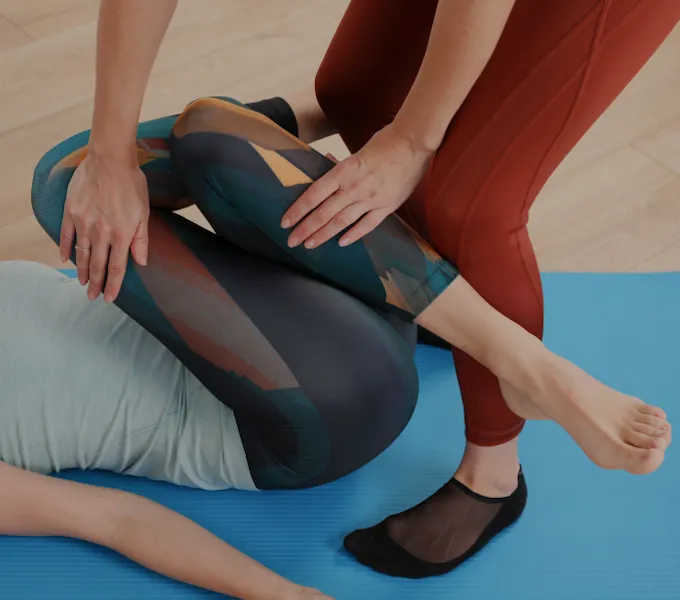
7 Tips for Healthy Poops from a Pelvic Floor PT
We don’t need to tell you that the state of your bowels can have an outsized impact on your life. From being so backed up it’s uncomfortable to move to getting the runs when you’re away from home, poop can really derail your day. If you have chronic bowel issues, they can disrupt your work, relationships, ability to exercise, and much more.
On that note, how’s your bowel function lately? Are you having regular movements, with good color and consistency, and little to no effort? Before you learn our top 7 pooping tips, scan the questions below — they'll give you an instant sense of how healthy your bowels are.
- How often do you poop? You don’t have to have a bowel movement every day to be healthy, but you should be able to have easy, pain-free poops anywhere from 3 times a day to 3 times a week.
- What color is your poop? Healthy poop is brown in color. Black or blond poop may indicate something may be off in your gastrointestinal system, so be sure to check with a doctor.
- What shape does it take? The best stool consistency looks firm with cracks or soft but still well-formed. Ideally, stool consistency should be type 4 on the chart below, but a 3 is pretty good, too.

- Are you emptying completely? Ideally, you can easily and completely empty your bowels, without needing to run back for another bowel movement a few minutes later.
- Can you hold it? You should be able to hold in your bowel movement if you get the urge at an inappropriate time to have a bowel movement, without having loss of stool or gas.
When it comes to poop, perfection isn’t possible — soft period poops, race day diarrhea, vacation constipation, or even holiday stress leakage — are bound to happen. If symptoms last, it’s important to consult with a healthcare provider to see if there may be an underlying issue that needs attention. And, of course, consider seeing a pelvic floor physical therapist so that we can help you improve your bowel function and overall pelvic health.
How to Poop to Prevent and Relieve Constipation
Now on to our top 7 pooping tips of all time. Here's what you can do to improve your bowel health and ensure that every poop goes as smoothly as possible.
1. Pay attention to your diet
Your bowel movements are the end result of your diet, so try to include plenty of fiber and water in your diet. Incorporate whole fruits and vegetables into your meals, and get enough water to keep your bowels happy — you should be drinking around ½ of your body weight in ounces (for example, if you weigh 150 pounds, aim to drink 75 ounces of water each day. When you pee, urine should be pale yellow to clear.
Some yummy high-fiber foods to eat more often:
- Raspberries
- Avocados
- Pears
- Artichokes
- Brussels sprouts
- Kale
- Lentils
- Chickpeas
- Rolled (not instant) oats
- Popcorn
- Almonds
- Chia seeds
If you struggle to get enough fiber from your diet, consider taking a supplement like Citrucel in the evenings before bed, this will also help with establishing a bowel routine.
2. Improve your pooping mechanics
For natural pelvic muscle function during bowel movements try the following posture recommendations:
- Start by getting your knees above your hips while sitting on the toilet. Depending on the height of your toilet, you can accomplish this by putting your feet on a step stool, sideways trash can, Squatty Potty, or even just raising your heels off of the ground. See the example below.

- Open your knees wider than your hips and allow your belly to sag down.
- Avoid slumping. Keep your back tall and hinge slightly forward resting your hands or elbows on your knees. You should feel almost like you are in a deep squatted position while sitting.
3. Breathe
Take a few relaxing breaths by breathing into your belly, consciously releasing your pelvic floor muscles with each inhale.
4. Push with a purpose
Push properly to prevent straining your pelvic floor muscles:
- Blow out (exhale) while pushing, as if you are blowing out a birthday candle. *For some making a “hissing” sound, or low grunting sound while exhaling is more effective.*
- Push your belly out like a balloon, instead of pulling your belly in to push. Combining the cues above, think “big belly, big cheeks” while pushing.
5. Go when you get the urge
Your natural urge to have a bowel movement will be what makes your bowel movement the easiest, which means you may need to have a bowel movement in a public bathroom. Use a seat cover and sit down — don't hover — for better body mechanics.
6. Keep moving
Regular physical activity and just moving your body can help your bowel function. Aim for daily, non-strenuous activity to support optimal bowel health.
7. Establish a routine
Prefer to have a bowel movement around the same time every day? A routine can help! Your bowels are often 2-3 times more active in the morning, so dedicating time in the morning to have a bowel movement can really be helpful.
Start your morning with a warm cup of water with lemon, and eat breakfast food that you can chew (vs. juice or a smoothie) — this will jump-start the digestive process. Then sit on the toilet for 10 minutes, 20-30 minutes after your meal, as this is generally when your bowels are primed for action. Before long, you'll likely find yourself pooping right on schedule.




